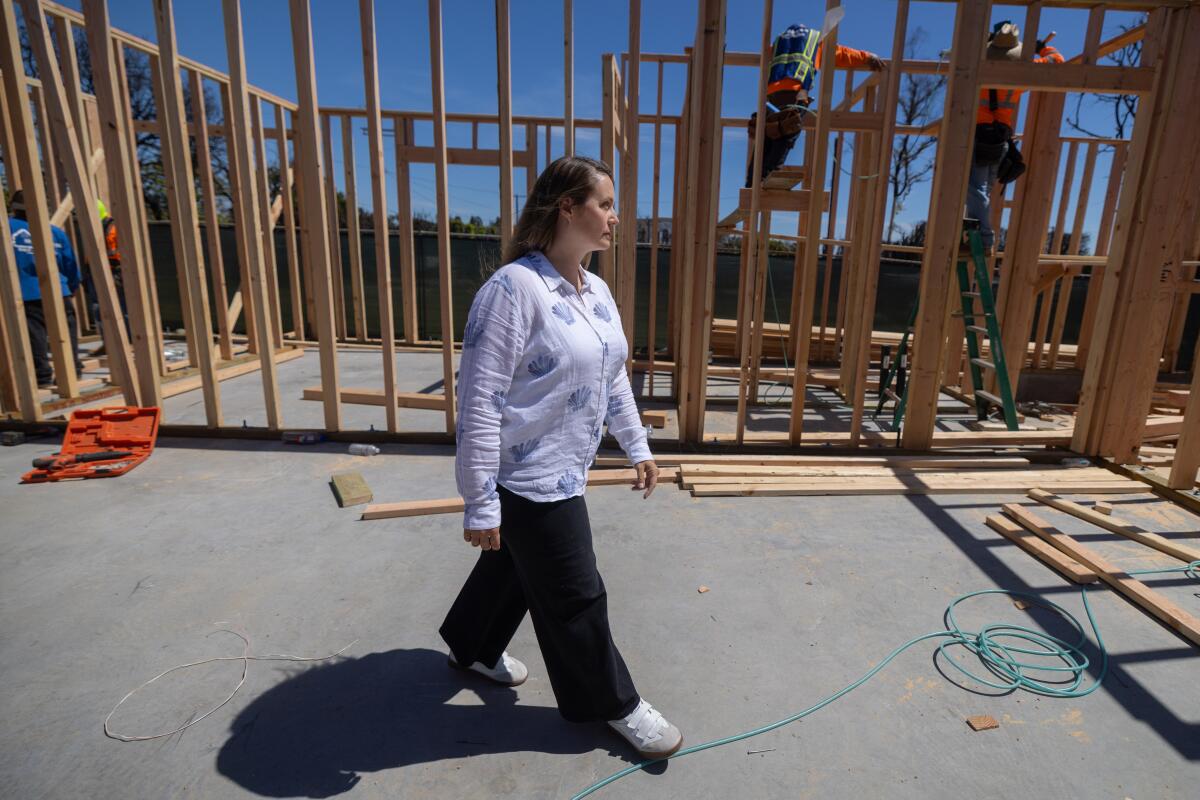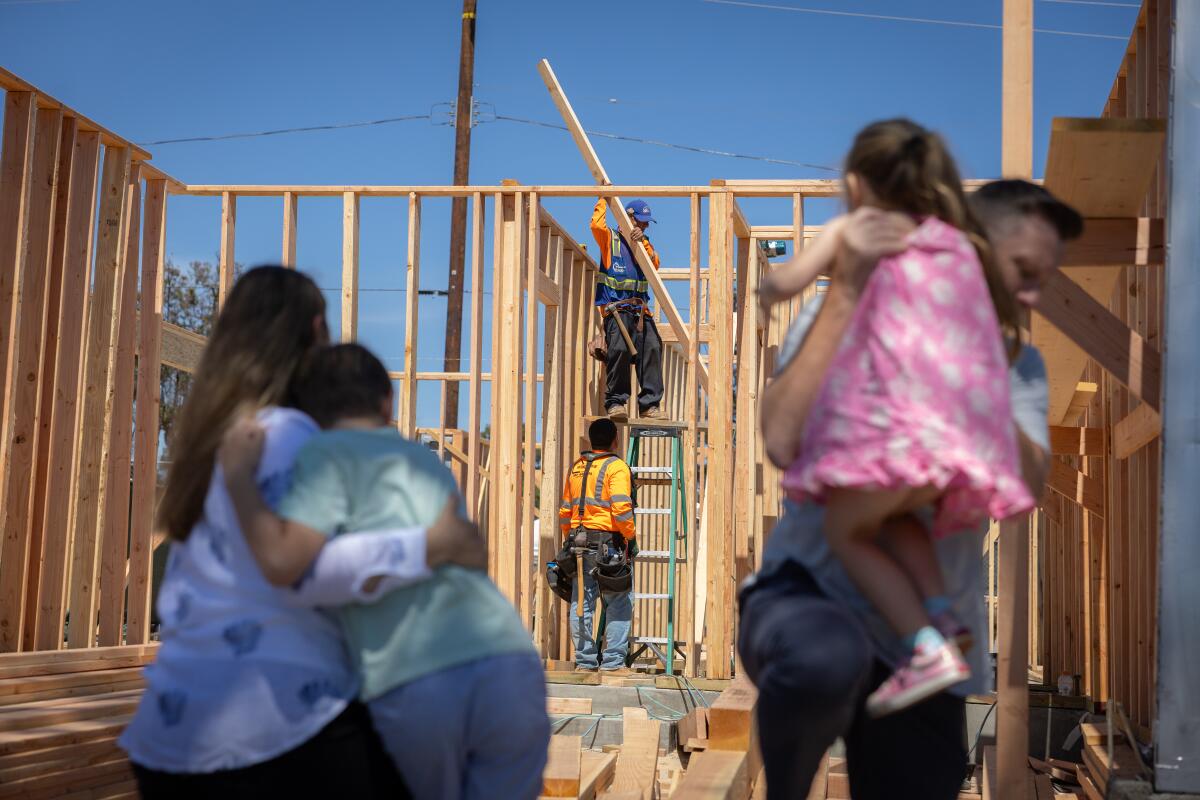Six months after fires, more than 800 homeowners in Palisades, Altadena have sought permits to rebuild

- Share via
- Rebuilding applications in Pacific Palisades, Altadena and other areas affected by January’s wildfires are accelerating, according to a Times data analysis. More than 800 homeowners submitted for permits as of July 6.
- On average, it’s taken 55 days for the city of Los Angeles to issue a permit, The Times’ analysis shows.
- Several architects and contractors say the permitting process is the quickest they’ve seen, while some fire survivors say they remain frustrated with red tape.
More than 800 homeowners in Pacific Palisades, Altadena and other areas affected by January’s wildfires have applied for rebuilding permits, according to a Times analysis of local government permitting data.
Of those, at least 145 have received approval to start construction on major repairs or replacement of their homes in the cities of Los Angeles, Malibu and Pasadena and in Altadena and other unincorporated areas of L.A. County, the analysis found.
At events this week commemorating the fires’ six-month mark, state and local leaders have celebrated the pace of cleanup efforts, touting their completion months ahead of schedule. Nearly 13,000 households were displaced by the Palisades and Eaton fires, which ripped through the communities Jan. 7 and 8.
“Now we turn the page to rebuilding, and we’re doing it with a clear plan, strong partnerships and the urgency this moment demands,” Gov. Gavin Newsom said in a statement.
Weekly data analyzed by The Times show an increasing pace of permit applications submitted to local authorities. Homeowners, architects and contractors working on approved projects praised the process as speedy and efficient. But some residents said that despite official promises of removing barriers and rapid turnarounds, they’ve been mired in delays.
A Times analysis shows that half the homes destroyed in Pacific Palisades and Altadena were rentals, raising questions about the future of affordable housing in the communities.
At many sites, construction is already underway. Five years ago, while pregnant with her second child, Alexis Le Guier and her husband, Andrew, moved into a newly constructed five-bedroom home in the Palisades’ Alphabet Streets area. A lifelong Angeleno, Le Guier wanted to take advantage of the neighborhood‘s schools and walkability, as well as live closer to her parents in Brentwood. The day after the fire, they started making calls to rebuild their home.
“The thought of moving was unfathomable,” said Le Guier, 41. “Of course I’m coming back. I can’t imagine being anywhere else.”

The Le Guiers, who were underinsured, benefited from having recent architectural plans, which saved them significant time and money. They made minor changes before submitting them to the city and received their permit 40 days later in early June. Their foundation was poured last week and lumber was delivered to the site soon after.
Many of the homeowners who have secured permits similarly had recent plans to work from or other advantages, such as quick insurance payouts, according to several architects and contractors. State and local officials have attempted to streamline the permitting process, especially for those who want to build homes comparable to the ones destroyed, by waiving some development rules and fees and opening “one-stop” centers that centralize planning and building reviews.
The city of Los Angeles has approved three permits for the rebuilding and repairs of Pacific Palisades homes affected by January’s wildfire.
Jason Somers, president of Crest Real Estate, a development firm, said the efforts have helped city plan checkers respond to applications with urgency.
“They are getting us permits quicker than we’ve ever seen before,” Somers said.

Somers’ firm is working on nearly 100 fire rebuilding projects, primarily in Pacific Palisades. Most of its clients, Somers said, aren’t ready to submit plans because they’re designing custom homes different from what they had previously. Somers said the city’s response so far encouraged him, but the test would come as the volume of applications increased.
“We shall see what the workflow looks like when we see 1,000 projects,” he said.
As of July 6, 389 homeowners had submitted applications to rebuild in the Palisades, roughly 8% of the 4,700 residential properties destroyed or majorly damaged by the fire, according to The Times’ analysis.
Property owners often need multiple permits. In addition to one for the main structure, the process might involve permits for demolition, electrical infrastructure, swimming pools, if included, and more. The Times’ analysis counts one application for each address no matter how many supplemental permits may be required. Additionally, the L.A. County data are limited to submissions that already have cleared an initial review by county planners.
Generally, applications at both the city and county level have been rising every week. The week of June 22 had the largest number for both the city and county with 36 and 34 submissions, respectively.

The city has approved nearly a quarter of those it’s received. L.A. County has issued permits for 15% of its 352 applications as of July 6, covering Altadena and unincorporated areas affected by the Palisades fire. In Pasadena, 20 property owners have submitted with two approved. For Malibu, 77 homeowners have submitted applications with none approved.
On average, it’s taken 55 days for the city of L.A. to issue a permit, including time it’s waited for applicants to respond to corrections, The Times’ analysis shows. The county process is slower. Once an application has been cleared by county planners, it’s been another 60 days on average for a building permit to be issued, according to the analysis.
Newsom and others, notably former L.A. mayoral candidate Rick Caruso, have criticized the pace of permitting, saying that recovery should be further along. On social media, fire survivors have lamented the red tape they’ve encountered.
Roberto Covarrubias, who has lived with his family in Altadena for a decade, said county officials haven’t delivered on their promises to make the process as fast as possible. His home was built in 2009 and he went to various offices seeking the original architectural plans — his paper copies burned in the fire — only to be told they didn’t exist. Weeks later, after Covarrubias hired a new architect, the county said it had located electronic plans for his old house.
Covarrubias wants to add a cellar to his new home to house the water heater and other machinery. County officials told him doing so would require additional soil testing, which he estimated would take a month and cost another $7,000. After three weeks of back-and-forth with his architect, Covarrubias said the county relented.
Any delay matters, he said. He wants to get ahead of the rush for workers and materials. And his insurance company will not release his payout until his rebuild permits are approved.
“It’s like a waterfall effect,” said Covarrubias, 50, an IT engineer.
His project remains in the permitting pipeline.
City and county officials have had to work through growing pains as they’ve attempted to implement the flurry of executive orders and programs designed to speed rebuilding.
Property owners had waited weeks in the spring, for instance, for guidelines on accessory dwelling unit construction. Last month, after sustained pressure from homeowners, the county agreed to waive permitting fees and refund those who already have paid. (The city waived its fees in April.) Both the city and the county continue testing ballyhooed artificial intelligence software to offer instant corrections to initial permit applications, with activation scheduled for this month.
With a boost from nonprofits, the city and county of Los Angeles are getting free AI permitting software. Will it speed up the process or add another hurdle to rebuilding?
The city has no immediate plans to hire additional staff or contractors to review permits because its staff is meeting its benchmarks for reviews, according to Gail Gaddi, a spokesperson for the Los Angeles Department of Building and Safety.
“However, we will continue to assess the needs of the department and will consider any adjustments as needed,” Gaddi said.
By contrast, County Supervisor Kathryn Barger, who represents areas affected by the Eaton fire, believes the county will need to add to its workforce to meet the demand.
“There needs to be additional staffing whether it’s contractors or permanent staffing,” said Helen Chavez Garcia, a spokesperson for the supervisor.
One of the more promising ways to expedite permitting is through preapproved architectural designs. The idea is that property owners could pick a model home that local governments already have signed off on, meaning the only further review needed was for issues specific to individual sites. The process has been credited for helping rapid recovery in Santa Rosa after the 2017 Tubbs fire.
Here, Somers’ firm is developing a suite of 50 plans called Case Study 2.0, named after the mid-20th century showcase of Southern California architecture. A newly formed San Gabriel Valley nonprofit, the Foothill Catalog Foundation, separately is hoping to design 50 model homes by the end of the year, said Alex Athenson, an architect and co-founder of the initiative. The catalog has had one design, a three-bedroom bungalow called “The Lewis,” approved by L.A. County. Athenson expects to submit nine more by the end of the month.
If a homeowner chooses a preapproved home, Athenson said, the entire permitting process could take two weeks or less.
“It would be incredible if homeowners can have that ease of access to starting construction,” Athenson said.
More to Read
Sign up for Essential California
The most important California stories and recommendations in your inbox every morning.
You may occasionally receive promotional content from the Los Angeles Times.











